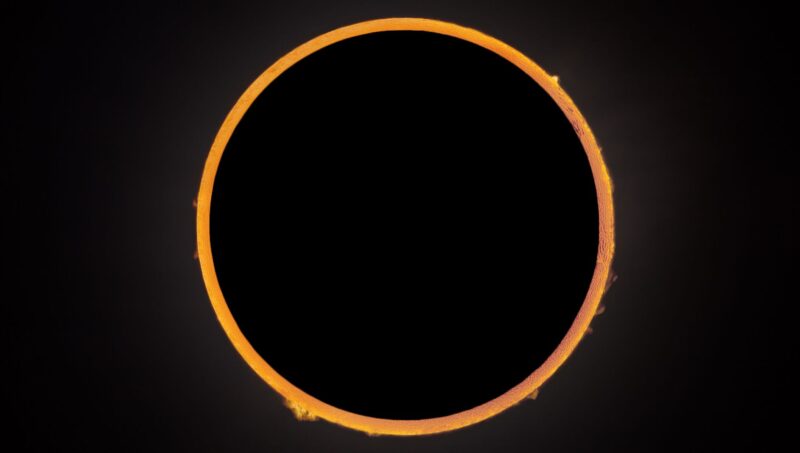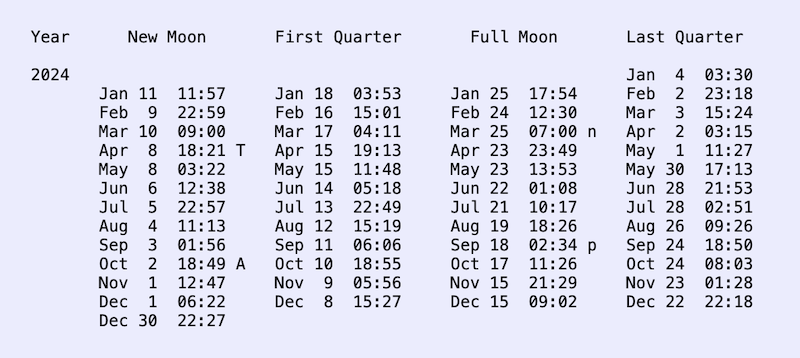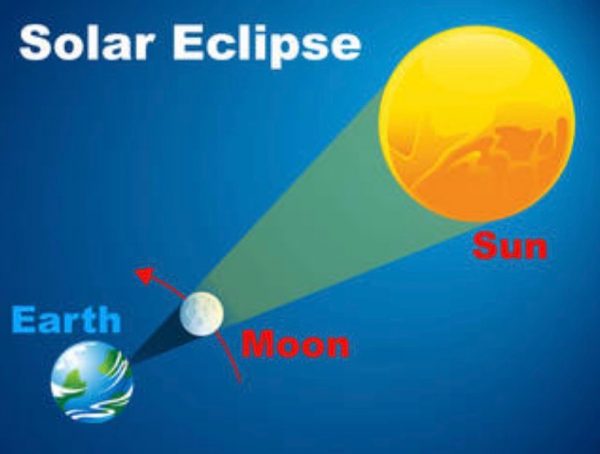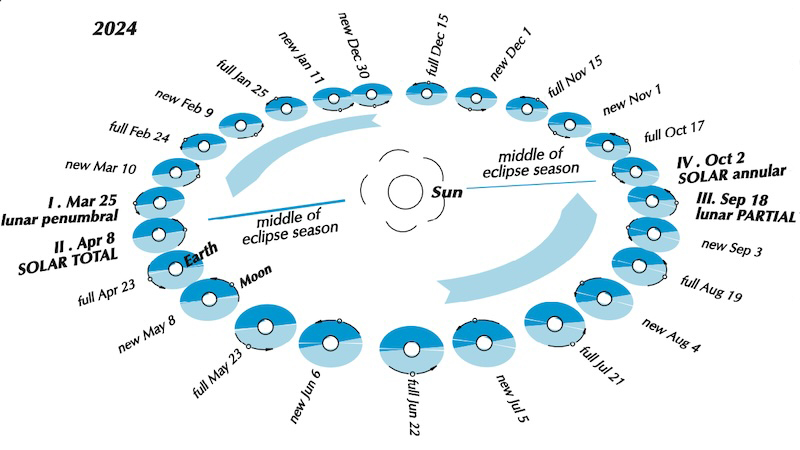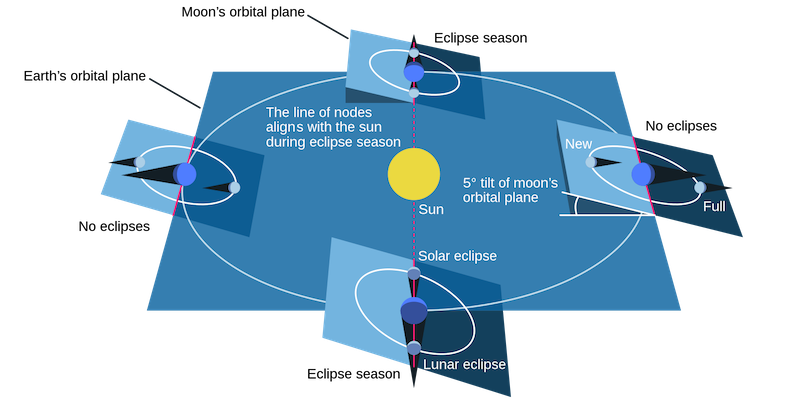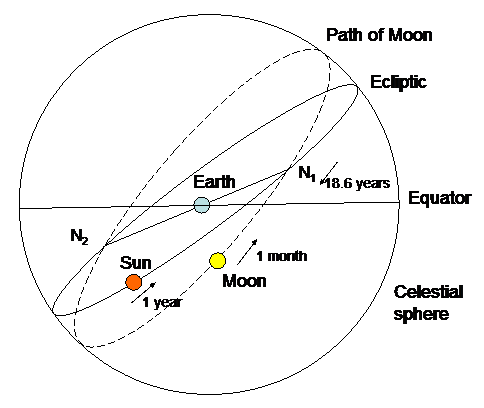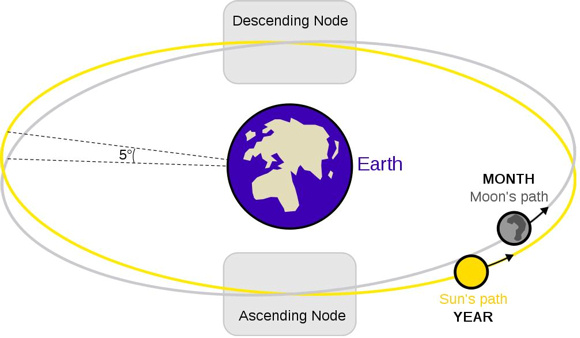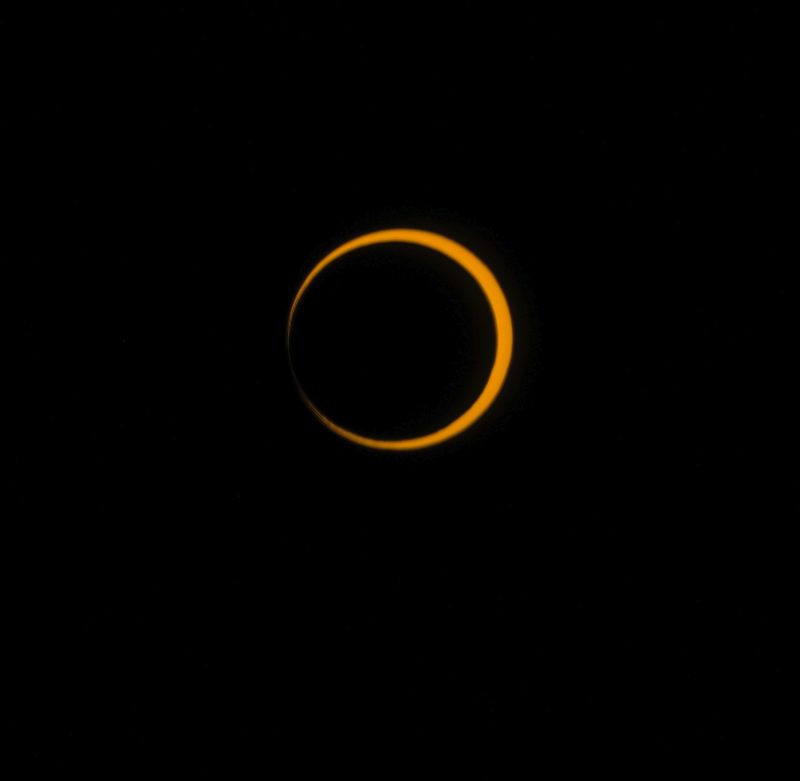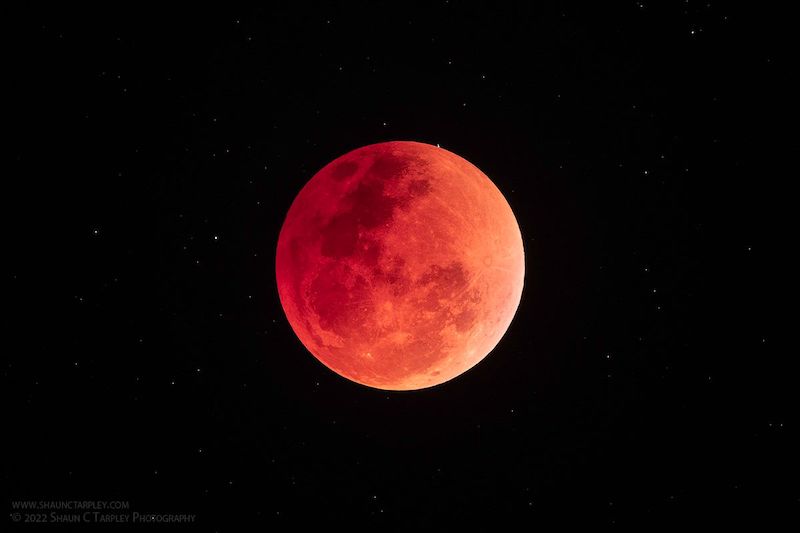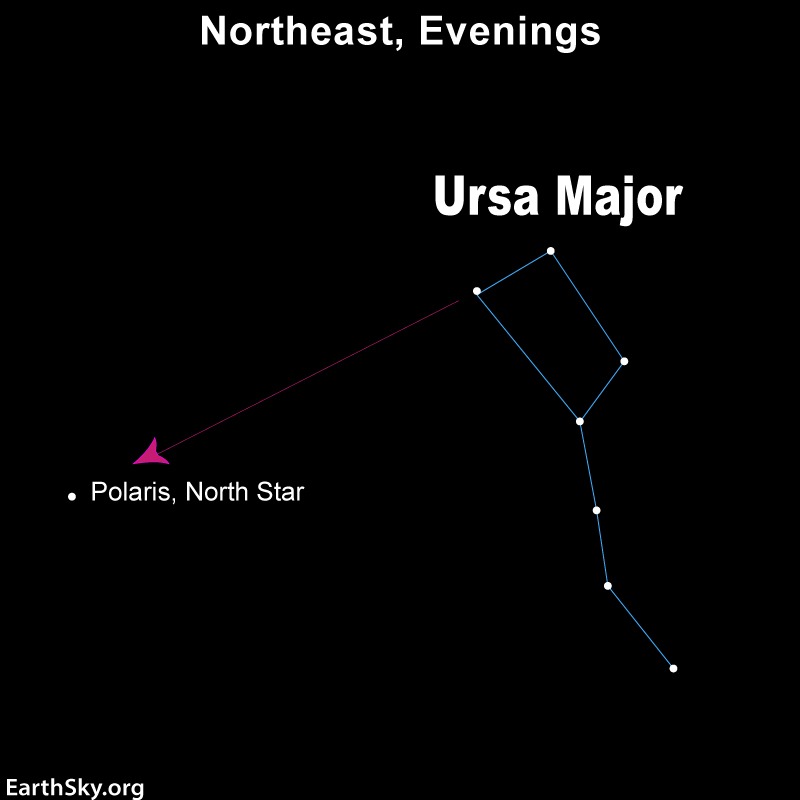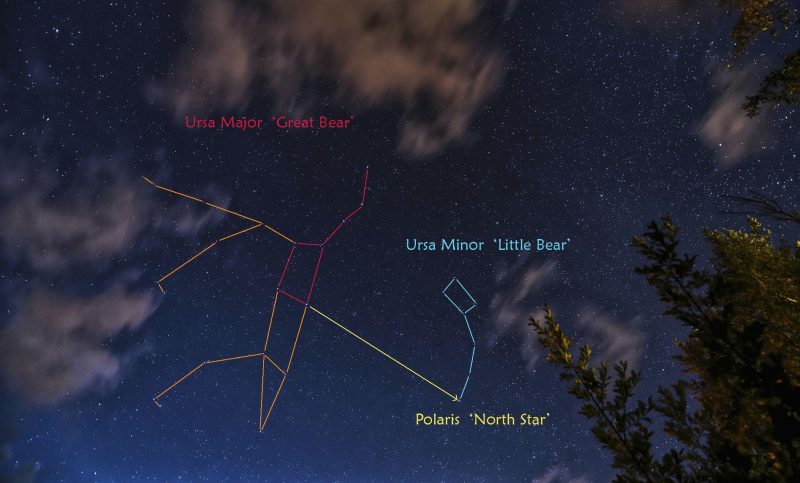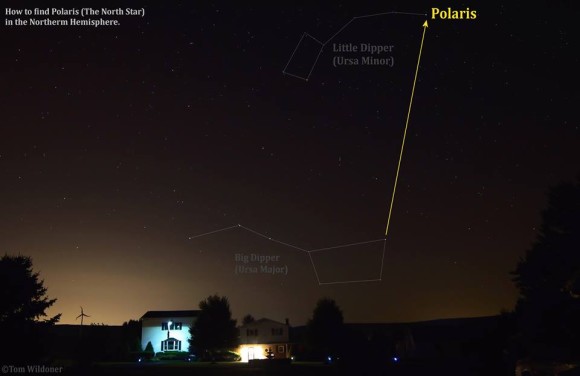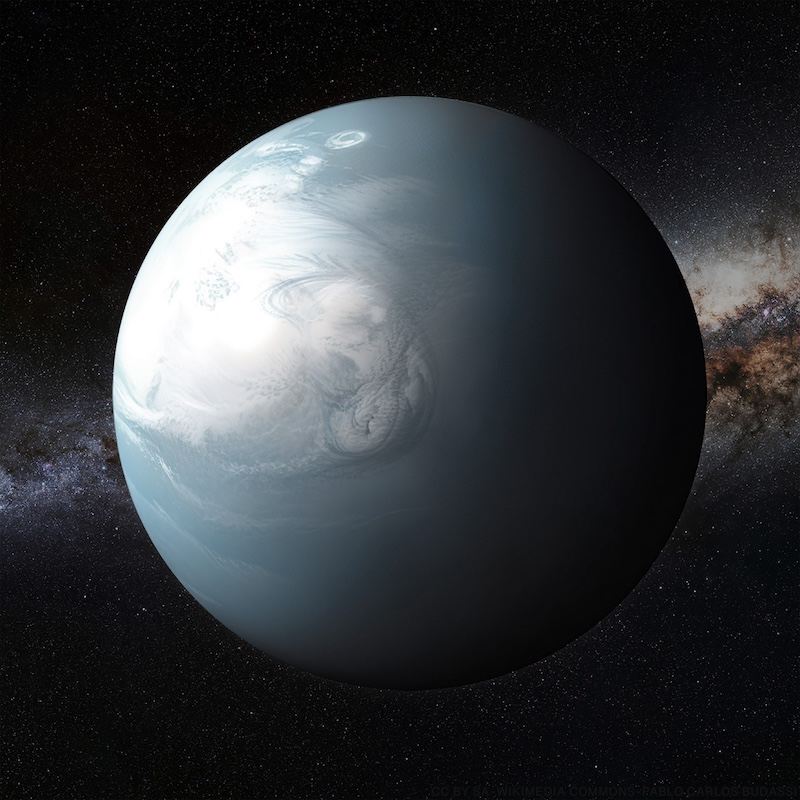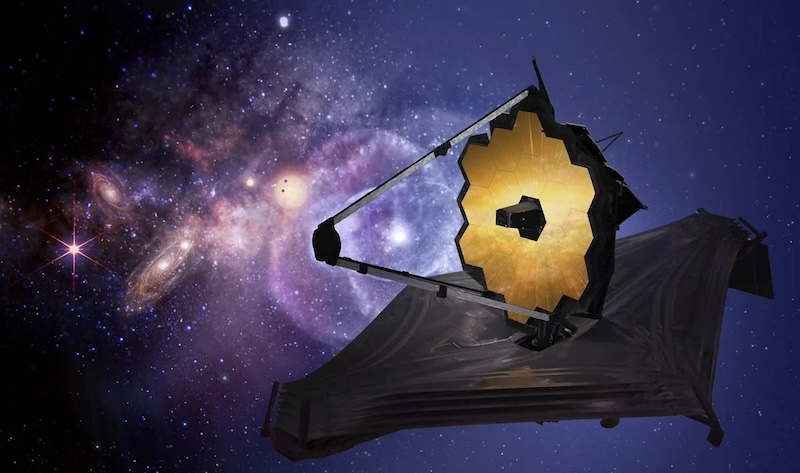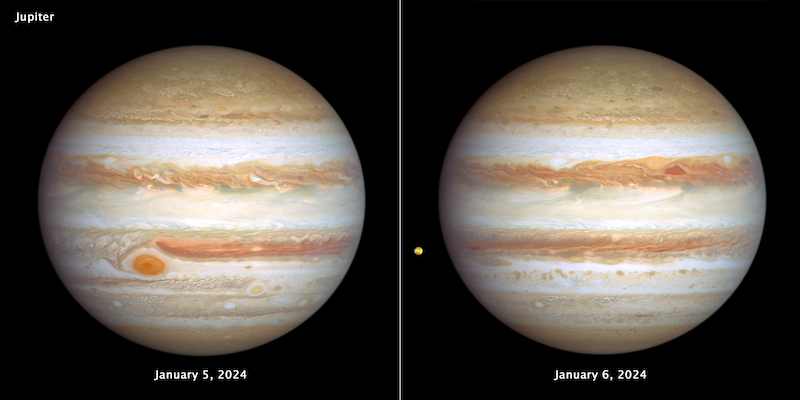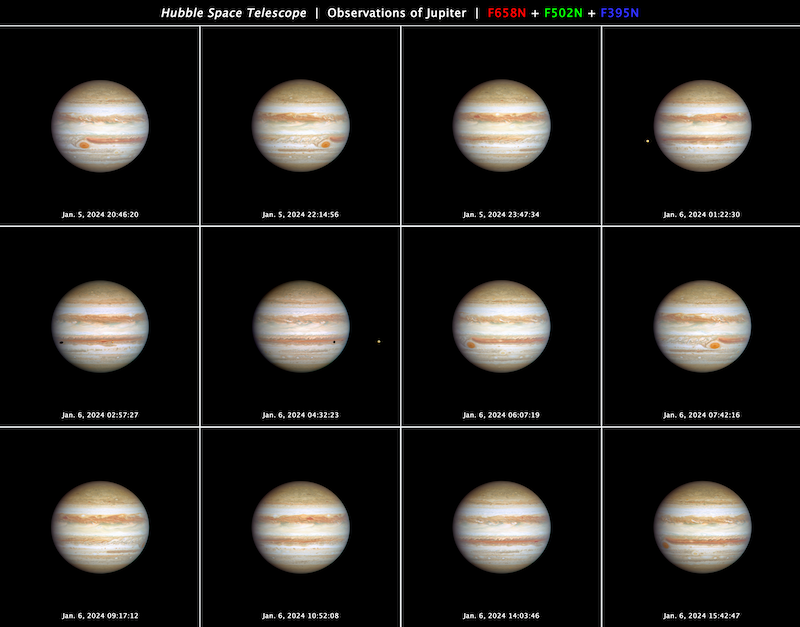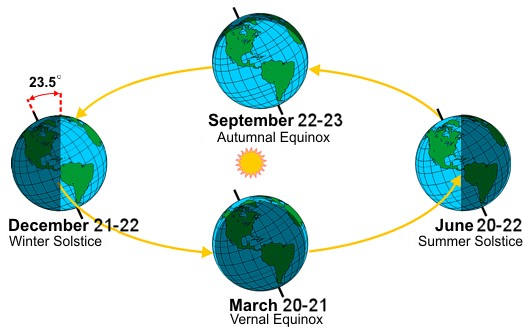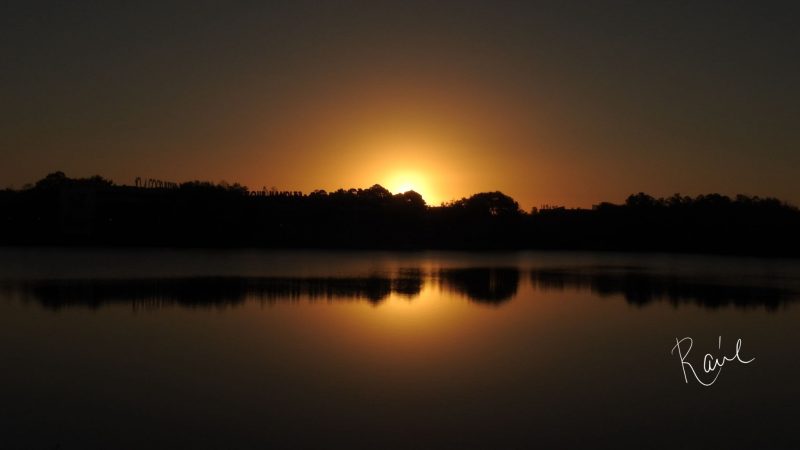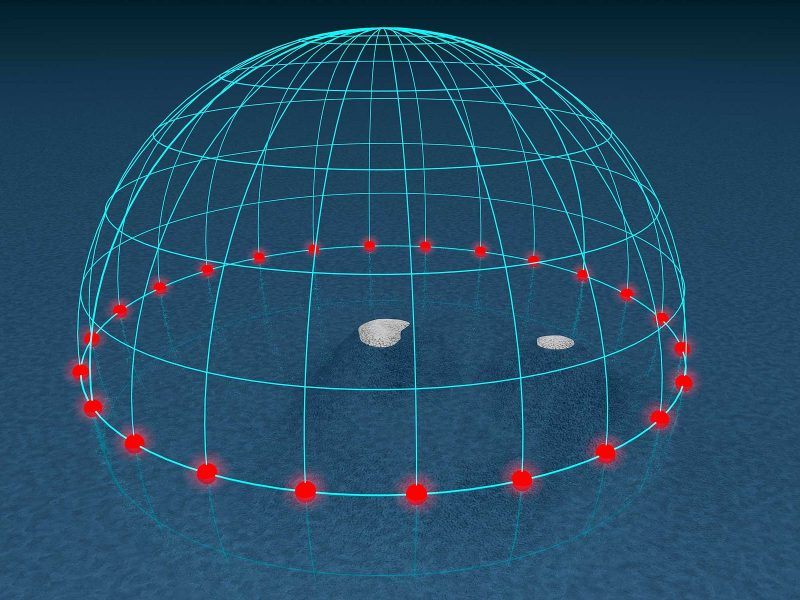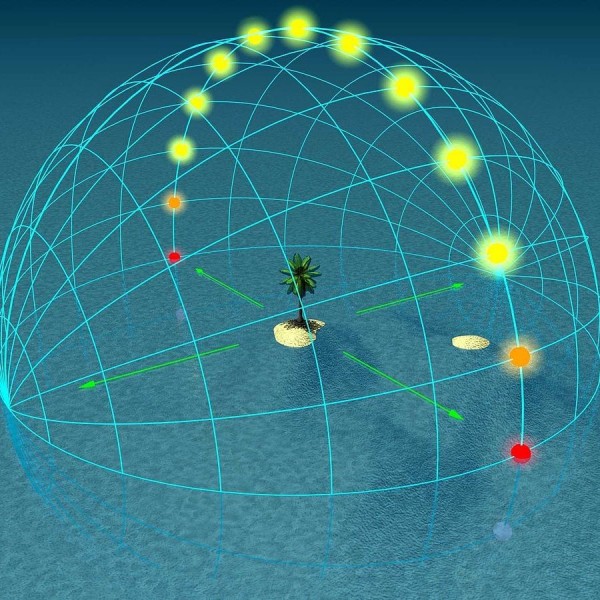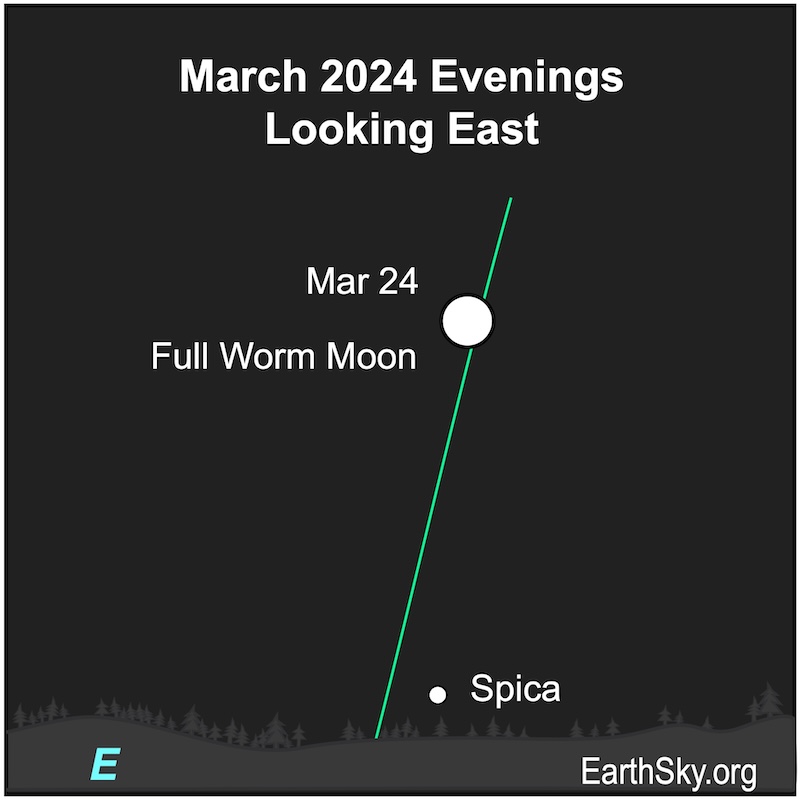
The March full moon 2024 is the closest full moon to the March equinox. It’s the full moon that sets 2024’s date of Easter Sunday as March 31. All the full moons have popular nicknames. Popular names for the March full moon are Worm Moon, Crow Moon and Sap Moon. The name Worm Moon honors the stirring of earthworms and insect larvae in the slowly warming late winter and early spring soil.
When to watch in 2024: Night of March 24-25
Where to look: Look for the bright round March full moon in the east in the evening, overhead around midnight, and in the west before sunrise. It is visible all night.
Crest of the full moon falls at 7 UTC on March 25, 2024. That’s 2 a.m. CDT in central North America. So if you live in central North America, your fullest moon will come before dawn on March 25, 2024.
There’s a penumbral lunar eclipse on March 24-24: Look for a penumbral eclipse beginning at 11:53 p.m. CDT on March 24 (4:53 UTC on March 25). It reaches mid-eclipse at 2:12 a.m. CDT on March 25 (7:12 UTC). The event ends at 4:33 a.m. CDT (9:33 UTC). At mid-eclipse the moon will be noticeably less bright. There will be a subtle shading on the moon: Earth’s lighter outer penumbral shadow.
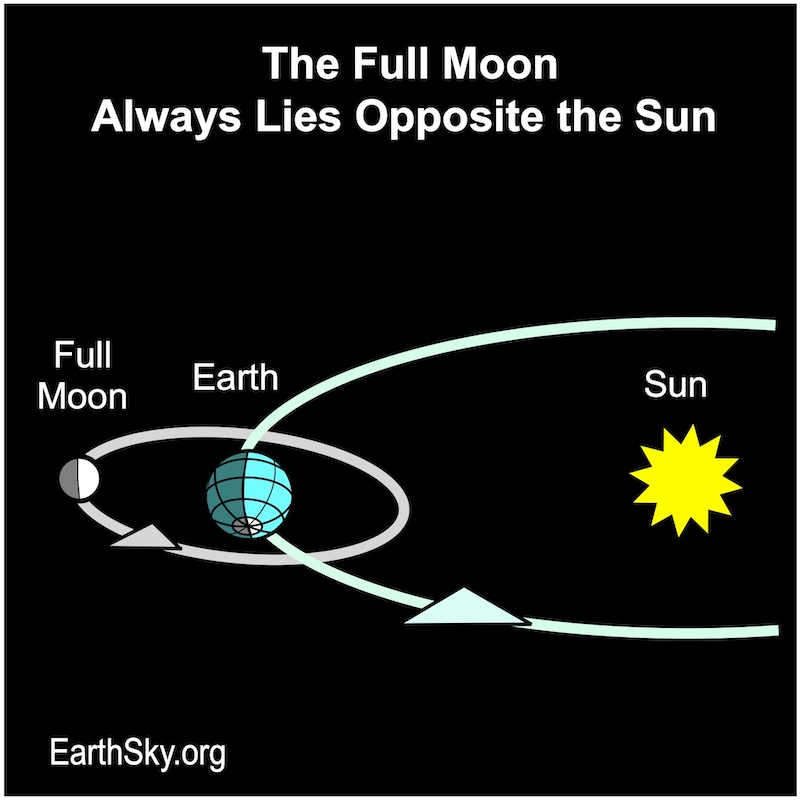
March full moon sees a partial penumbral eclipse
Night owls will see the March full moon slide into a partial penumbral eclipse on March 25 beginning at 4:53 UTC. That is 11:53 p.m. CDT on March 24. It reaches mid-eclipse at 2:12 a.m. CDT and the event ends at 4:33 a.m. CDT. At mid-eclipse the moon’s brightness will have dimmed, but it will still be easily visible. From the moon’s point of view, Earth does not completely block the sun during a penumbral eclipse as would happen during a total umbral lunar eclipse.
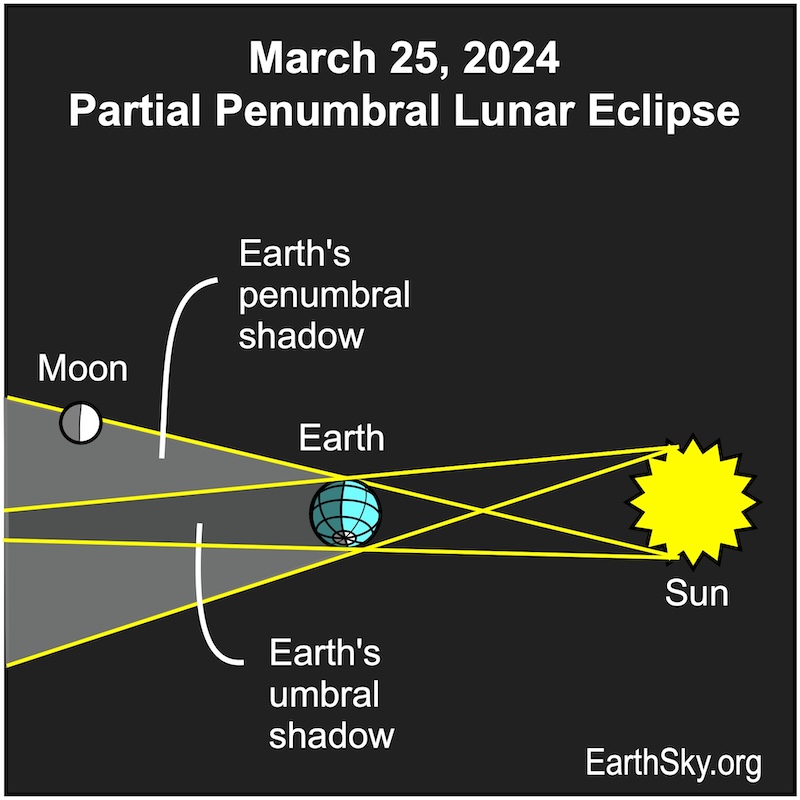
March full moons and Easter
The March full moon sometimes sets the date of Easter Sunday, as it does in 2024. In 2024, we have a full moon on March 24-25. Easter comes on the first Sunday following the full moon after the March equinox. So Easter is on March 31, 2024.
Read: When is Easter? And how is Easter tied to the night sky?
Opposite a Harvest Moon
The March 24 full moon is the closest full moon to 2024’s March equinox, which fell at 3:06 UTC on March 20.
It’s the spring equinox for the Northern Hemisphere. And it’s the autumn equinox for the Southern Hemisphere. So for us in the Northern Hemisphere, the March full moon shows characteristics opposite those of a Harvest Moon. Meanwhile, in the Southern Hemisphere, this full moon has all the Harvest Moon characteristics.
What are the Harvest Moon’s characteristics?
We in the Northern Hemisphere have a tradition of full moon names. We use the term Harvest Moon for the full moon nearest the autumn equinox, in September or October.
And many of the full moons do have unique, seasonal characteristics. All full moons rise at or around sunset. But – because the moon moves eastward in orbit – the moon typically rises about 50 minutes later with each passing day. And, around the time of the Harvest Moon, there’s only a short lag time between successive moonrises. The lag time between successive moonrises reaches a yearly minimum. For instance, at and around 40 degrees south latitude – around the time of the March full moon – the moon rises only about 30 to 35 minutes later daily.
So for the Southern Hemisphere, the short time between successive moonrises continues for several days. And – around the time of the autumn equinox and March full moon – there’s a bright full-looking moon in the early evening sky for several evenings in a row.
March full moon characteristics
In the Northern Hemisphere, in many years, the March full moon is the closest full moon to our spring equinox. So the lag time between successive moonrises reaches a yearly maximum. In other words, there’s an especially long time between moonrises, from one night to the next, around the time of the March full moon.
For instance, at 40 degrees north latitude, the moon rises some 75 minutes later from one night to the next around the time of the March full moon. The longer-than-usual time between successive moonrises continues for several days. So – around the time of the spring equinox and the March full moon – there’s a longer-than-usual period of darkness (no moon) in early evening, for several days in a row around new moon after the date of the full moon.
Arc of March full moon
And it’s not just moonrise times. It’s also the height of the moon’s arc across our sky that follows a specific pattern from month to month and season to season. Every full moon rises in the east as the sun sets in the west. Every full moon arcs across the sky throughout the night and sets around dawn. For us in the Northern Hemisphere, the arc of this March full moon is lower than the paths of the full moons of December, January and February. But it is higher than the paths in April, May, and June.

For those in the Southern Hemisphere, the full moon’s arc across the sky is climbing higher with each successive month. It’ll continue to do so until around the June solstice.
March full moon in Virgo
The full moon on the night of March 24, 2024, is located in the direction of the constellation Virgo. It glows far above Virgo’s brightest star, Spica.

Penumbral lunar eclipse photos from our EarthSky community
Submit your photo to EarthSky here.
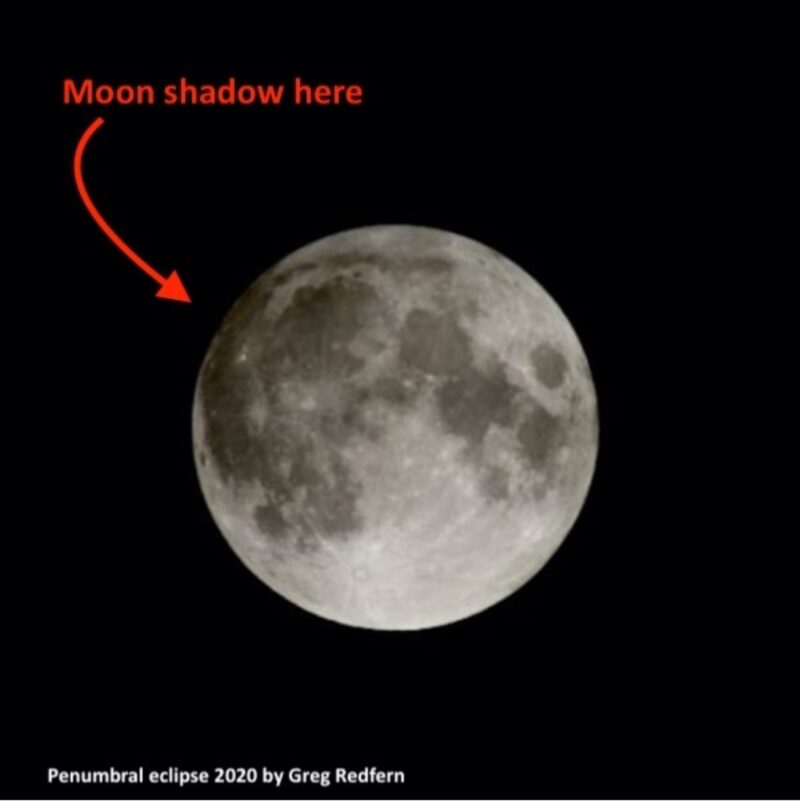
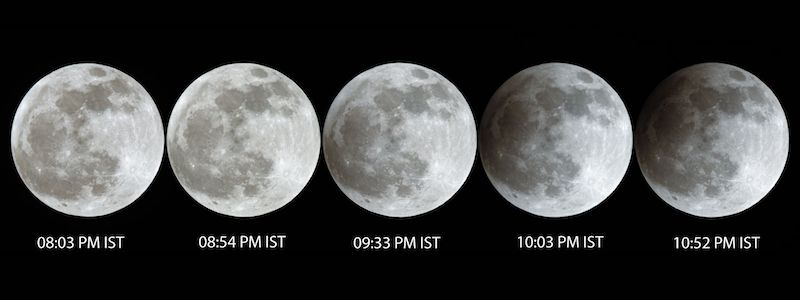
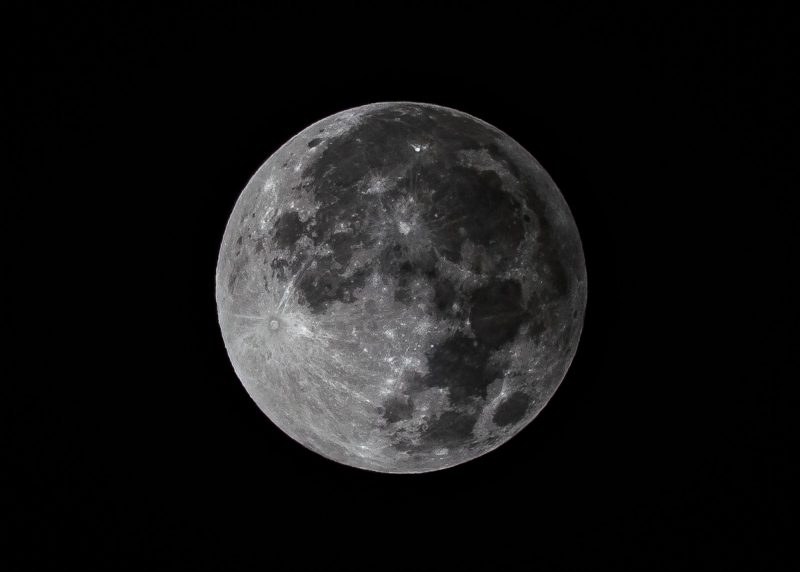
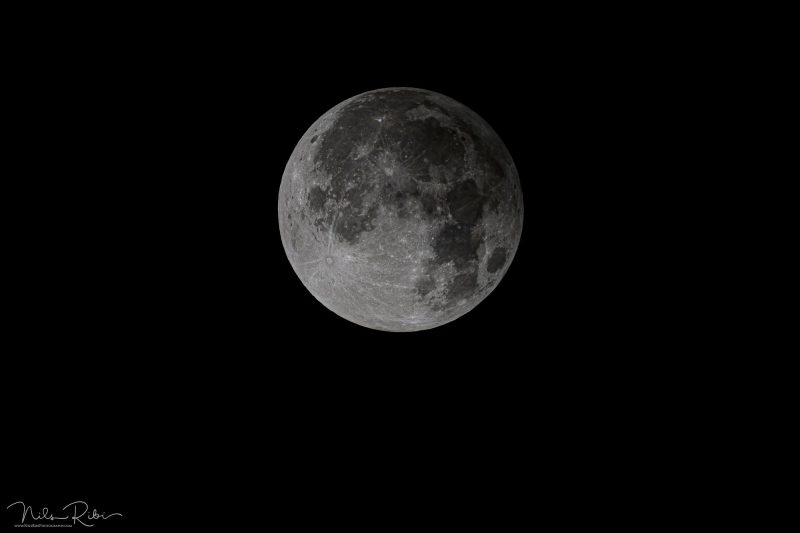
More photos of penumbral lunar eclipses
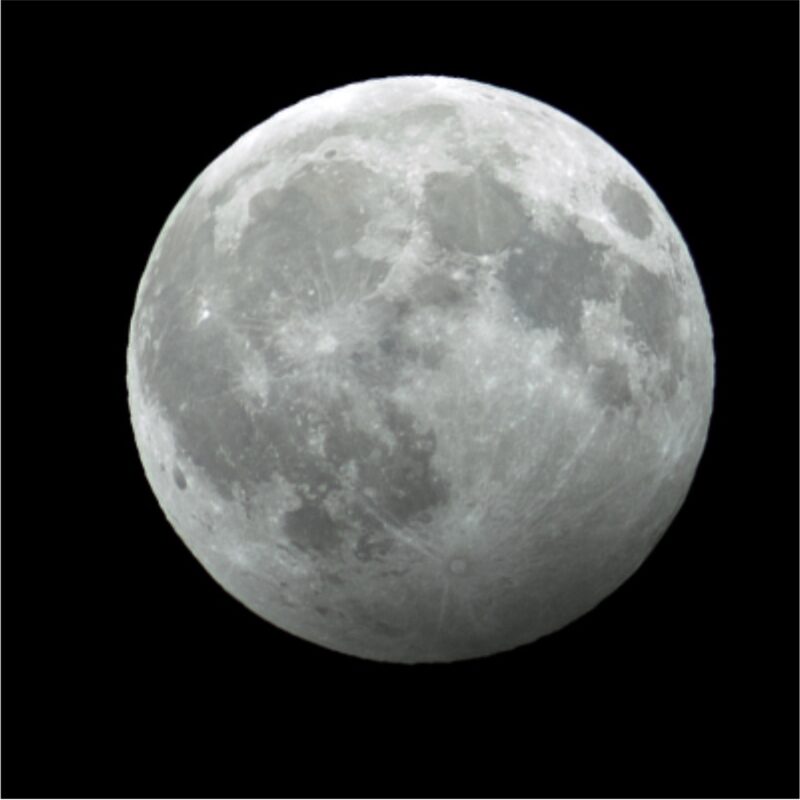
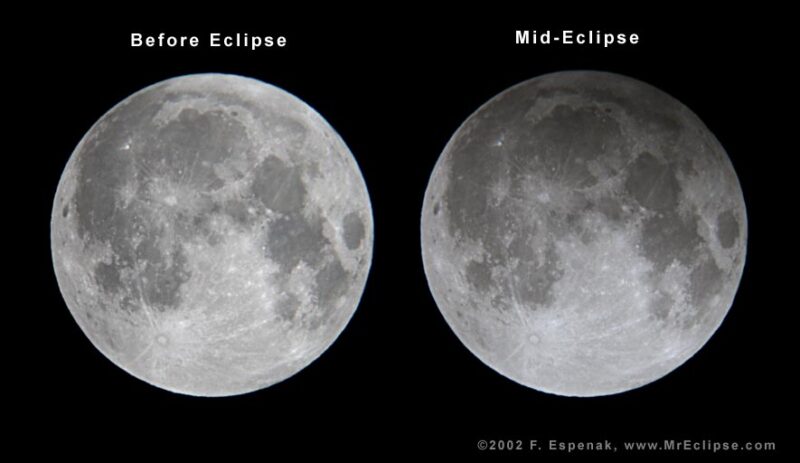
Bottom line: The March full moon on the overnight of March 24-25, 2024, is above the bright star Spica in the constellation Virgo. Watch for it from dusk to dawn and see the partial penumbral lunar eclipse beginning at 11:53 p.m. CDT on March 24!
The post March full moon is the Worm Moon first appeared on EarthSky.
from EarthSky https://ift.tt/aijDhTE

The March full moon 2024 is the closest full moon to the March equinox. It’s the full moon that sets 2024’s date of Easter Sunday as March 31. All the full moons have popular nicknames. Popular names for the March full moon are Worm Moon, Crow Moon and Sap Moon. The name Worm Moon honors the stirring of earthworms and insect larvae in the slowly warming late winter and early spring soil.
When to watch in 2024: Night of March 24-25
Where to look: Look for the bright round March full moon in the east in the evening, overhead around midnight, and in the west before sunrise. It is visible all night.
Crest of the full moon falls at 7 UTC on March 25, 2024. That’s 2 a.m. CDT in central North America. So if you live in central North America, your fullest moon will come before dawn on March 25, 2024.
There’s a penumbral lunar eclipse on March 24-24: Look for a penumbral eclipse beginning at 11:53 p.m. CDT on March 24 (4:53 UTC on March 25). It reaches mid-eclipse at 2:12 a.m. CDT on March 25 (7:12 UTC). The event ends at 4:33 a.m. CDT (9:33 UTC). At mid-eclipse the moon will be noticeably less bright. There will be a subtle shading on the moon: Earth’s lighter outer penumbral shadow.

March full moon sees a partial penumbral eclipse
Night owls will see the March full moon slide into a partial penumbral eclipse on March 25 beginning at 4:53 UTC. That is 11:53 p.m. CDT on March 24. It reaches mid-eclipse at 2:12 a.m. CDT and the event ends at 4:33 a.m. CDT. At mid-eclipse the moon’s brightness will have dimmed, but it will still be easily visible. From the moon’s point of view, Earth does not completely block the sun during a penumbral eclipse as would happen during a total umbral lunar eclipse.

March full moons and Easter
The March full moon sometimes sets the date of Easter Sunday, as it does in 2024. In 2024, we have a full moon on March 24-25. Easter comes on the first Sunday following the full moon after the March equinox. So Easter is on March 31, 2024.
Read: When is Easter? And how is Easter tied to the night sky?
Opposite a Harvest Moon
The March 24 full moon is the closest full moon to 2024’s March equinox, which fell at 3:06 UTC on March 20.
It’s the spring equinox for the Northern Hemisphere. And it’s the autumn equinox for the Southern Hemisphere. So for us in the Northern Hemisphere, the March full moon shows characteristics opposite those of a Harvest Moon. Meanwhile, in the Southern Hemisphere, this full moon has all the Harvest Moon characteristics.
What are the Harvest Moon’s characteristics?
We in the Northern Hemisphere have a tradition of full moon names. We use the term Harvest Moon for the full moon nearest the autumn equinox, in September or October.
And many of the full moons do have unique, seasonal characteristics. All full moons rise at or around sunset. But – because the moon moves eastward in orbit – the moon typically rises about 50 minutes later with each passing day. And, around the time of the Harvest Moon, there’s only a short lag time between successive moonrises. The lag time between successive moonrises reaches a yearly minimum. For instance, at and around 40 degrees south latitude – around the time of the March full moon – the moon rises only about 30 to 35 minutes later daily.
So for the Southern Hemisphere, the short time between successive moonrises continues for several days. And – around the time of the autumn equinox and March full moon – there’s a bright full-looking moon in the early evening sky for several evenings in a row.
March full moon characteristics
In the Northern Hemisphere, in many years, the March full moon is the closest full moon to our spring equinox. So the lag time between successive moonrises reaches a yearly maximum. In other words, there’s an especially long time between moonrises, from one night to the next, around the time of the March full moon.
For instance, at 40 degrees north latitude, the moon rises some 75 minutes later from one night to the next around the time of the March full moon. The longer-than-usual time between successive moonrises continues for several days. So – around the time of the spring equinox and the March full moon – there’s a longer-than-usual period of darkness (no moon) in early evening, for several days in a row around new moon after the date of the full moon.
Arc of March full moon
And it’s not just moonrise times. It’s also the height of the moon’s arc across our sky that follows a specific pattern from month to month and season to season. Every full moon rises in the east as the sun sets in the west. Every full moon arcs across the sky throughout the night and sets around dawn. For us in the Northern Hemisphere, the arc of this March full moon is lower than the paths of the full moons of December, January and February. But it is higher than the paths in April, May, and June.

For those in the Southern Hemisphere, the full moon’s arc across the sky is climbing higher with each successive month. It’ll continue to do so until around the June solstice.
March full moon in Virgo
The full moon on the night of March 24, 2024, is located in the direction of the constellation Virgo. It glows far above Virgo’s brightest star, Spica.

Penumbral lunar eclipse photos from our EarthSky community
Submit your photo to EarthSky here.




More photos of penumbral lunar eclipses


Bottom line: The March full moon on the overnight of March 24-25, 2024, is above the bright star Spica in the constellation Virgo. Watch for it from dusk to dawn and see the partial penumbral lunar eclipse beginning at 11:53 p.m. CDT on March 24!
The post March full moon is the Worm Moon first appeared on EarthSky.
from EarthSky https://ift.tt/aijDhTE

